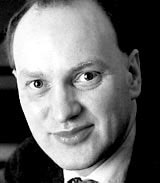Bored minds think alike
Similarity of ideas which shape trends in design may be purely coincidental, but Hugh Pearman thinks it’s to do with the length of creatives’ attention spans

The phenomenon known as morphic resonance, as I’m sure you know, occurs when different beings in different places have the same idea all at once, without obvious direct communication. Example: back in the days when there were doorstep milk deliveries and lots of urban birdlife, there was a moment when every bluetit in the UK suddenly started pecking through the foil tops of milk bottles. They all simultaneously acquired the knowledge, or at least the desire to try. No one knows how.
Talk of bluetits somehow or other brings me back to the police. In my last column, I floated the idea that the seemingly defunct idea of the police box, aka Tardis, might be due a revival, particularly in crime hotspots. I’ve now got a newspaper cutting in front of me with the headline ‘Police boxes make a comeback to help turn tide of crime’. This time they are officially described as ‘kiosks’, will cost around £75 000 each and will, basically, do the same job as police boxes used to, only with a bit more room and a computer terminal. The first ones will arrive in north London shortly. Am I psychic? Has morphic resonance been at work? I suspect these kiosks won’t look too good, but if the idea takes off, there ought to be a product design job for someone in it.
Anyhow, that’s enough about the thin blue line. What about these sudden, inexplicable shifts in ideas? Morphic resonance may be believable in the lower orders of the animal kingdom, but is it really credible for it to happen among humans as well? Can we excuse all those suspiciously similar logos that enliven the Letters pages of this magazine, on the grounds that everyone happened to have the same idea at the same time? In other words – is this not blatant copying, but simple common endeavour?
It’s a beguiling notion. Haven’t you always wondered at the fact that everyone always seems to have the same idea in fashion at the same time? Come the catwalk shows, there’s always a ‘story’ – the story being peasant tops, or slashed trousers, or the military look, or whatever. Maybe there’s massive industrial espionage going on among the designers, but that wouldn’t explain why the same thing happens in street fashion. This summer, it was all distressed-denim skirts. Why this year rather than last, or next? Ditto hairstyles, glasses, boots… Arguably street fashion is all to do with chaos theory – one tiny event results in colossal change elsewhere – but I’d rather see it as the grandest human expression of morphic resonance. You don’t know where it begins or ends, it just happens.
In architecture, of course, it’s the curvy look that swept the profession globally around the turn of the millennium, and shows no signs of abating yet. In small cars, it’s that cheeky sit-up-and-beg look. Some of them are now so tall, you could drive with a basket of fruit on your head. What’s the point? The point is this is what all small-car designers are drawing. No one knows why, beyond the fact that nobody wants a product that’s too far out of line with the rest – except Fiat with its toad-like Multipla. But there are always brave exceptions, just as some architects still doggedly design right-angled buildings.
Planes? Same applies, but on a longer product cycle. Everyone used to design passenger jets with wing-mounted engines. They then clustered the engines at the tail. Then they put them back on the wings. But why these shifts? Why the trend for little A5 magazines in the consumer market, as opposed to the huge, floppy ones in the 1980s?
Some of these things have an obvious stimulus. Most low-cost airlines try to look friendly and cuddly, in contrast to the stern technocratic or nationalistic liveries of the big intercontinental carriers. Since they all operate cute little Boeing 737s, this is not difficult to achieve. It’s harder to make a 747-400 look cute, or Concorde. Nor can we invoke morphic resonance for the rise of the low-cost airline business. That’s a simple matter of me-too: one airline did it well, so everybody pitched in. Cause followed effect.
Where it is less obvious, it comes down to this. Designers get bored of always doing the same thing. And they all get bored in the same way at around the same time. So they all dream up something different and original. And so does everyone else. So all these fresh original ideas turn out to be remarkably similar, since everybody’s minds work in the same way. Except graphic designer Alan Fletcher’s, obviously. Some people have built-in brain shields that make them wholly immune to morphic resonance. The greatest minds do not think alike.
-
Post a comment




